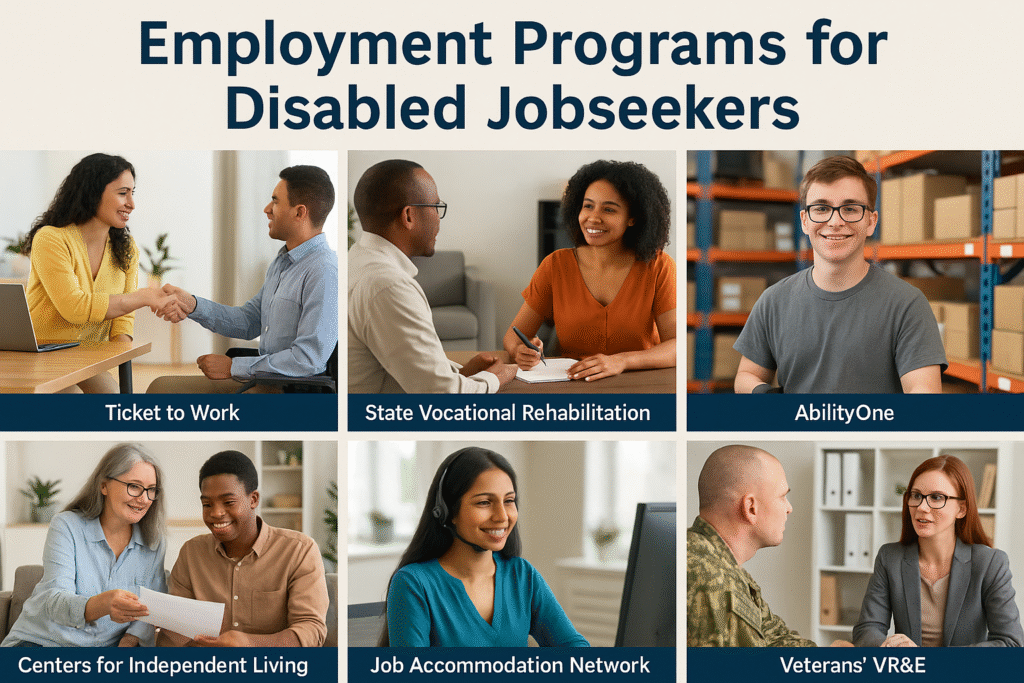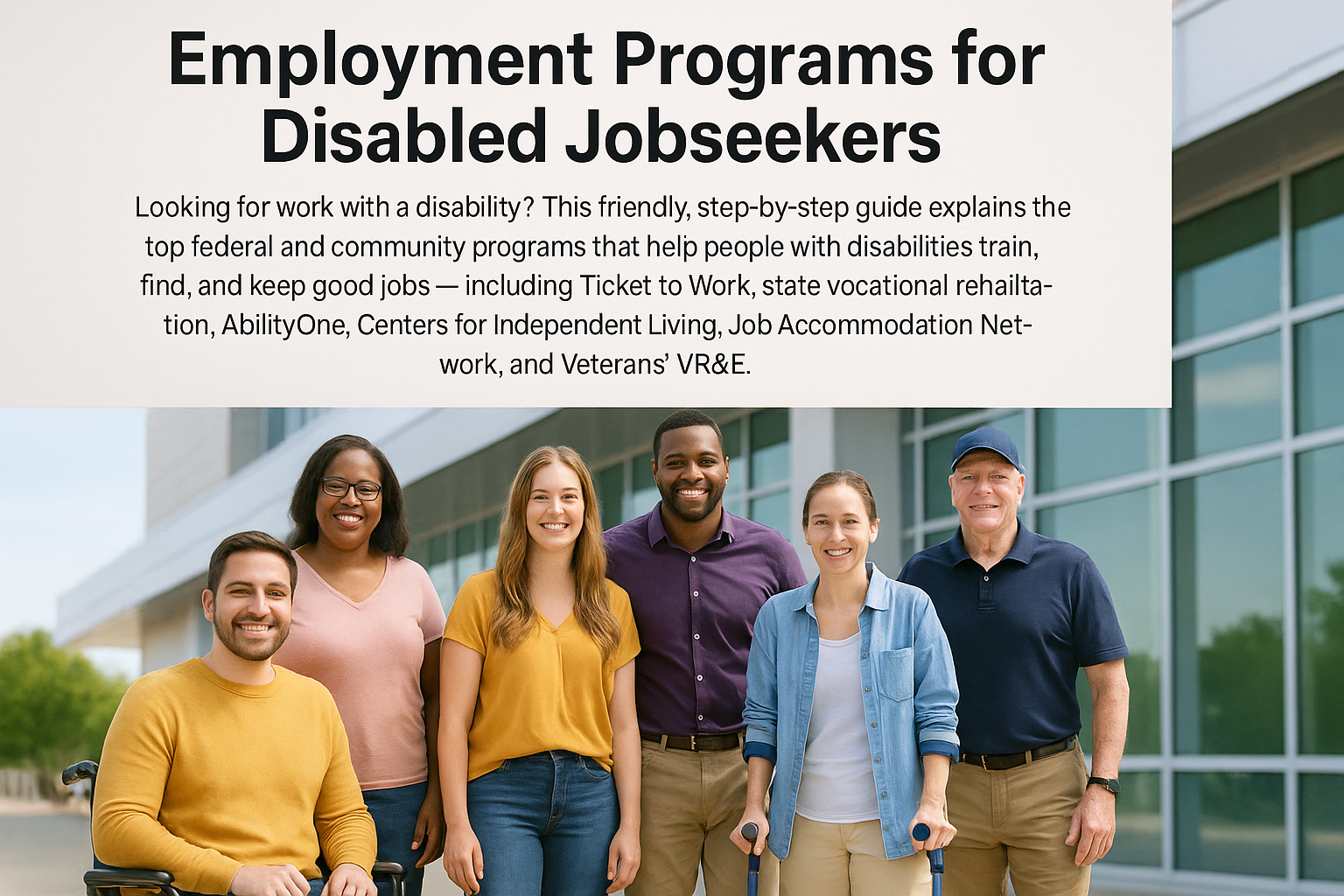Employment programs for disabled: Looking for work with a disability? This friendly, step-by-step guide explains the top federal and community programs that help people with disabilities train, find, and keep good jobs — including Ticket to Work, state vocational rehabilitation, AbilityOne, Centers for Independent Living, Job Accommodation Network, and Veterans’ VR&E. All information below is based on official U.S. government sources .
Why this matters (one quick truth)
Employment programs for disabled: Work can boost independence, income, and community connection — and there are proven programs ready to help you get job skills, accommodations, and employer connections while protecting benefits when needed. Below is a clear roadmap to the most useful programs and how to use them.
The top programs and who they help (at-a-glance)
- Ticket to Work (Social Security) — For people ages 18–64 who receive SSDI or SSI and want training, supports, and a safe path to employment while preserving benefits protections. The program is voluntary and free.
- State Vocational Rehabilitation (VR) agencies — Offer job training, workplace assessment, assistive tech, and job placement for people with significant disabilities. Every state and territory has a VR agency funded through the Rehabilitation Services Administration.
- AbilityOne Program — Helps people who are blind or have significant disabilities find jobs performing work for federal agencies and nonprofit employers; it’s one of the largest sources of employment for people with disabilities nationwide.
- Job Accommodation Network (JAN) — Free expert guidance on workplace accommodations, disability disclosure, and ADA/Section 504 questions for both employees and employers. JAN helps you figure out practical solutions you can request from employers.
- Centers for Independent Living (CILs) — Local, consumer-controlled organizations offering independent living skills, peer support, and help finding employment-related resources. They are community-based and run by people with disabilities.
- Veteran Readiness & Employment (VR&E / Chapter 31) — For veterans with service-connected disabilities, VR&E helps with training, job search, resume building, and starting businesses. Managed by the VA.
- Federal hiring paths and resources (USAJOBS & agency SPPCs) — Many federal agencies have Selective Placement Program Coordinators and special hiring authorities for applicants with disabilities; USAJOBS lists tips and unique hiring paths.
Step-by-step plan: how to use these programs (follow in order)
Step 1 — Decide whether you want to test work while keeping benefits
If you receive SSDI or SSI and are unsure about trying work, Ticket to Work is the safest first step. It connects you to Employment Networks or your state VR office and explains Work Incentives (how earnings affect benefits). It’s free and voluntary.
Step 2 — Contact your state Vocational Rehabilitation (VR) agency
VR agencies are the single best place for individualized job training, career counseling, assistive technology, and placement services when you have a disability that impacts work. You can apply directly to your state VR office; funding and eligibility rules vary but VR is available in every state and territory. If eligible, VR can often pay for training, equipment, and job coaching.

Step 3 — If you’re blind or have significant disabilities, explore AbilityOne
AbilityOne placements provide stable, mission-focused jobs across the country through nonprofit agencies that contract with the federal government. If your functional limitations are significant and you prefer supported employment, AbilityOne is a major national option to explore.
Step 4 — Learn about workplace accommodations and plan requests with JAN
Before interviewing or when you have a job offer, JAN provides free, confidential guidance about reasonable accommodations, low- or no-cost solutions, and how to request them from an employer under the ADA. Use JAN to build clear accommodation requests and examples.
Step 5 — Use Centers for Independent Living (CILs) for local help
CILs provide in-person support, peer counseling, and referrals for job search training and community resources — especially helpful if you need hands-on help getting to interviews, building soft skills, or locating adaptive tech. Find your local CIL through directories.
Step 6 — Veterans: apply for VR&E if you’re service-connected
If you’re a veteran with a service-connected disability and want employment assistance, apply for VA VR&E (Chapter 31). VR&E offers individualized plans that can include training, certifications, job placement, and support setting up a business.
Step 7 — For federal jobs: use USAJOBS and agency SPPCs
If you want federal employment, check USAJOBS’ guidance for applicants with disabilities and contact agency Selective Placement Program Coordinators (SPPCs) who can explain special hiring authorities and reasonable accommodations during hiring.
Quick checklist you can copy & use
- Are you on SSDI/SSI and unsure about work? Call Ticket to Work or visit choosework.ssa.gov.
- Apply to your state VR agency — ask about training, assistive tech, and supported employment.
- If blind or significantly disabled, search AbilityOne jobs.
- Contact JAN for accommodation ideas before interviewing or disclosing.
- Locate your local CIL for peer support and practical help.
- Veterans: Apply to VR&E (Chapter 31) at va.gov/careers-employment.
Common FAQs (short answers)
Q: Will going to work make me lose my disability benefits?
A: Not immediately. Ticket to Work and SSA work incentives let many people try work while protecting benefits during a trial period. Talk with Ticket counselors before starting.
Q: Who pays for training or assistive tech?
A: If you’re eligible, state VR agencies often cover training, adaptive equipment, and job coaching. VA VR&E and AbilityOne have their own funding mechanisms for eligible participants.
Q: How do I ask for an accommodation?
A: Use JAN (askjan.org) to identify practical accommodation options and how to request them. Employers must provide reasonable accommodations unless it causes undue hardship.
Real-world tips that help
- Keep a short “work strengths” list: what you can do reliably, tools that help you, and accommodations that make you successful. Use it in interviews.
- Use recorded mock interviews and practice disclosing your disability only to the extent that helps you get the job. JAN can help script this.
- Combine services: many jobseekers use VR for training, Ticket to Work for benefit protections, and a local CIL for community supports — you don’t have to pick just one.
Disclaimer
This post offers general information about federal and local employment programs for people with disabilities. It is not legal, medical, or financial advice. Program rules, eligibility, and contact info change — always confirm details with the official program or agency before making decisions.
Helpful official links (clickable)
- USA.gov — Job training and employment programs for people with disabilities (source). (USAGov)
https://www.usa.gov/disability-jobs-training - Ticket to Work (Social Security) — program overview & how to enroll. (Social Security)
https://www.ssa.gov/work/ · https://choosework.ssa.gov/ - CareerOneStop — Workers with Disabilities resources and job-search tools. (CareerOneStop)
https://www.careeronestop.org/ResourcesFor/WorkersWithDisabilities/workers-with-disabilities.aspx - AbilityOne Program — employment for people who are blind or have significant disabilities. (AbilityOne)
https://www.abilityone.gov/ - Job Accommodation Network (JAN) — free guidance on accommodations and ADA. (askjan.org)
https://askjan.org/ - State Vocational Rehabilitation agencies (RSA directory). (rsa.ed.gov)
https://rsa.ed.gov/about/states - Centers for Independent Living directory (ILRU). (ilru.org)
https://www.ilru.org/projects/cil-net/cil-center-and-association-directory - VA — Veteran Readiness & Employment (VR&E / Chapter 31) for veterans with service-connected disabilities. (benefits.va.gov)
https://www.benefits.va.gov/vocrehab/ · https://www.va.gov/careers-employment/vocational-rehabilitation/apply-vre-form-28-1900/
